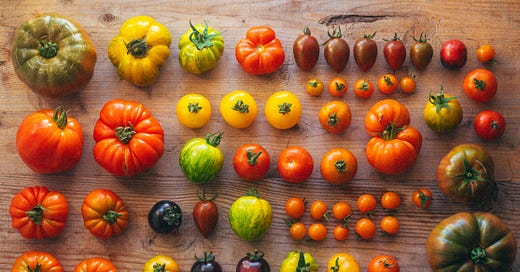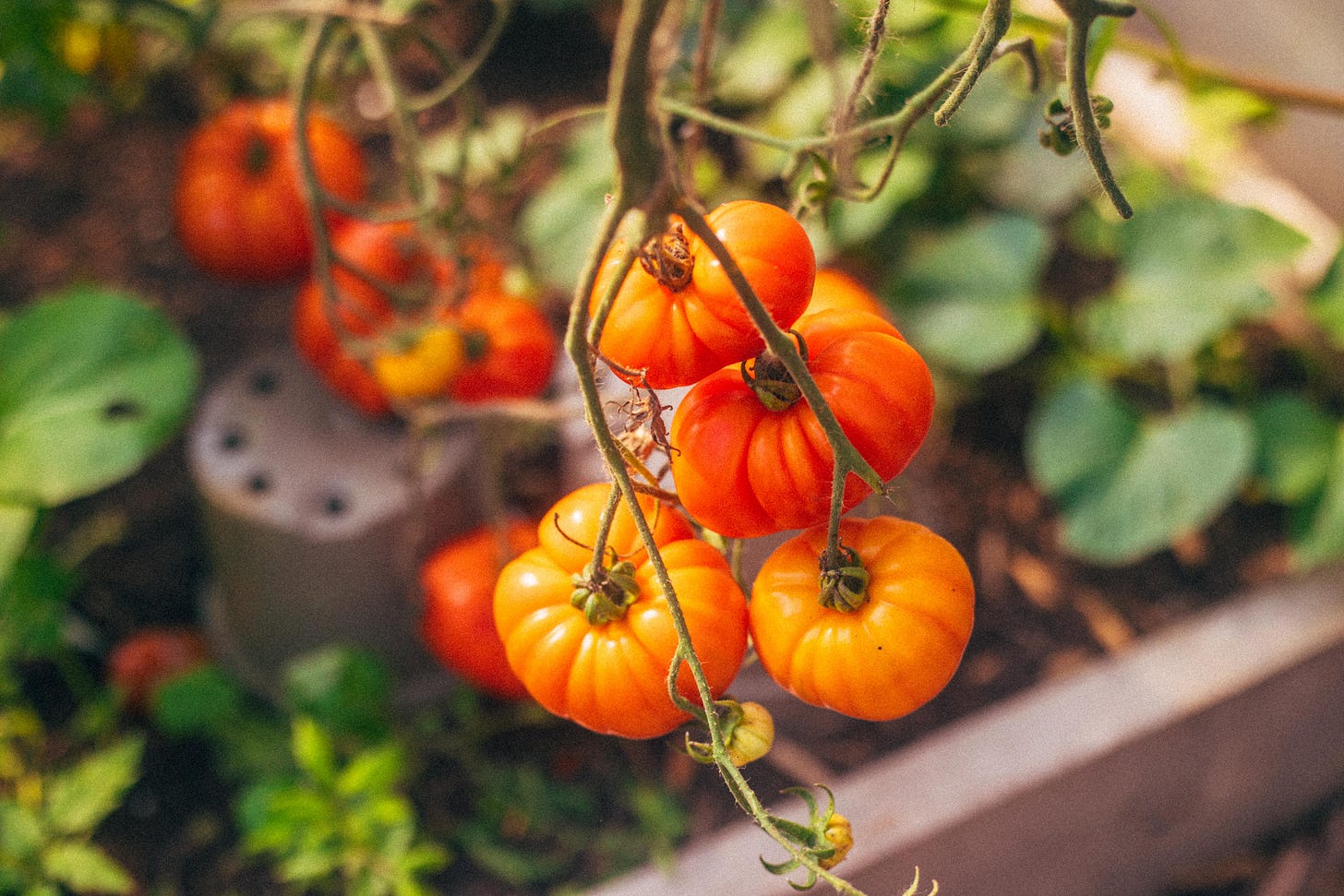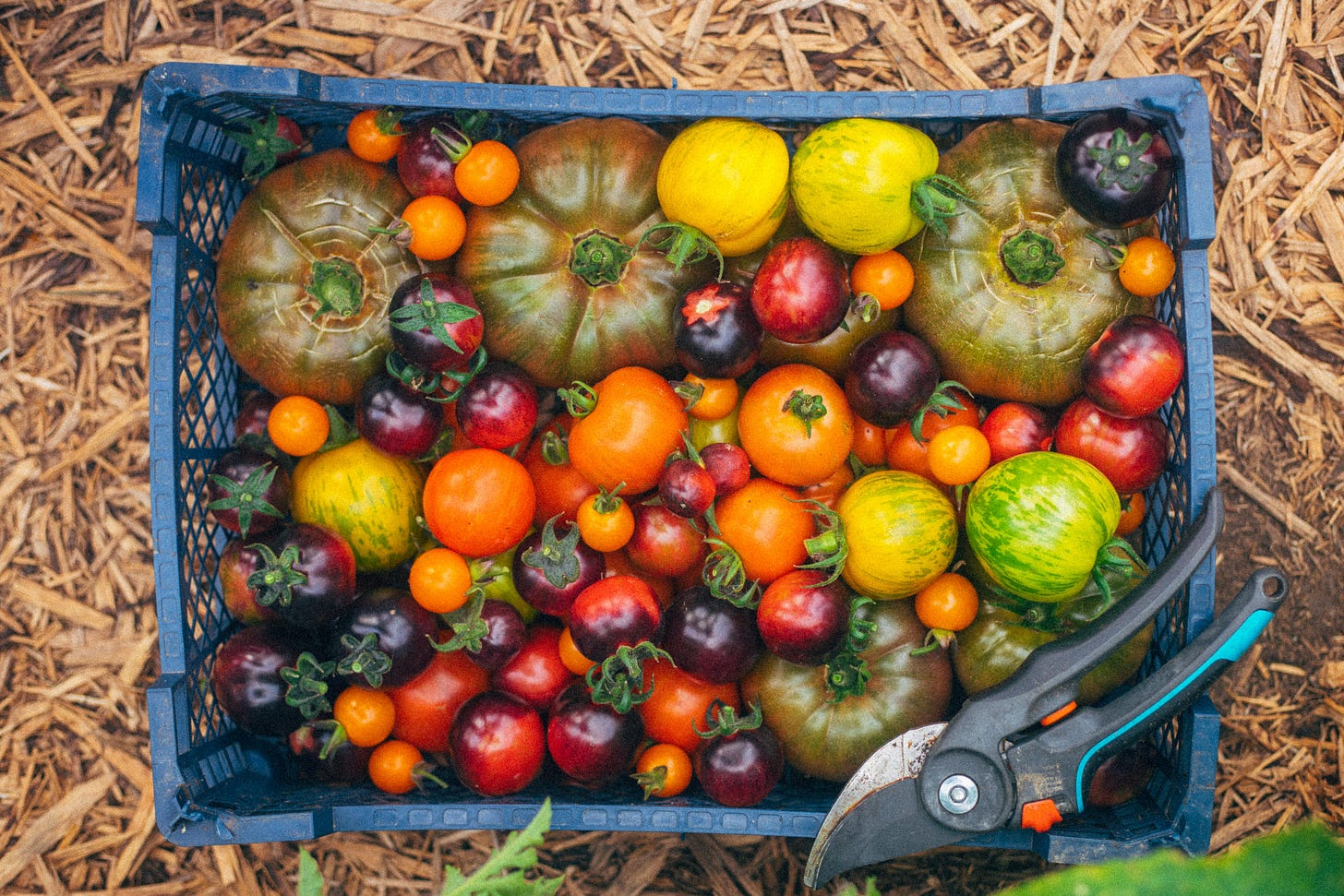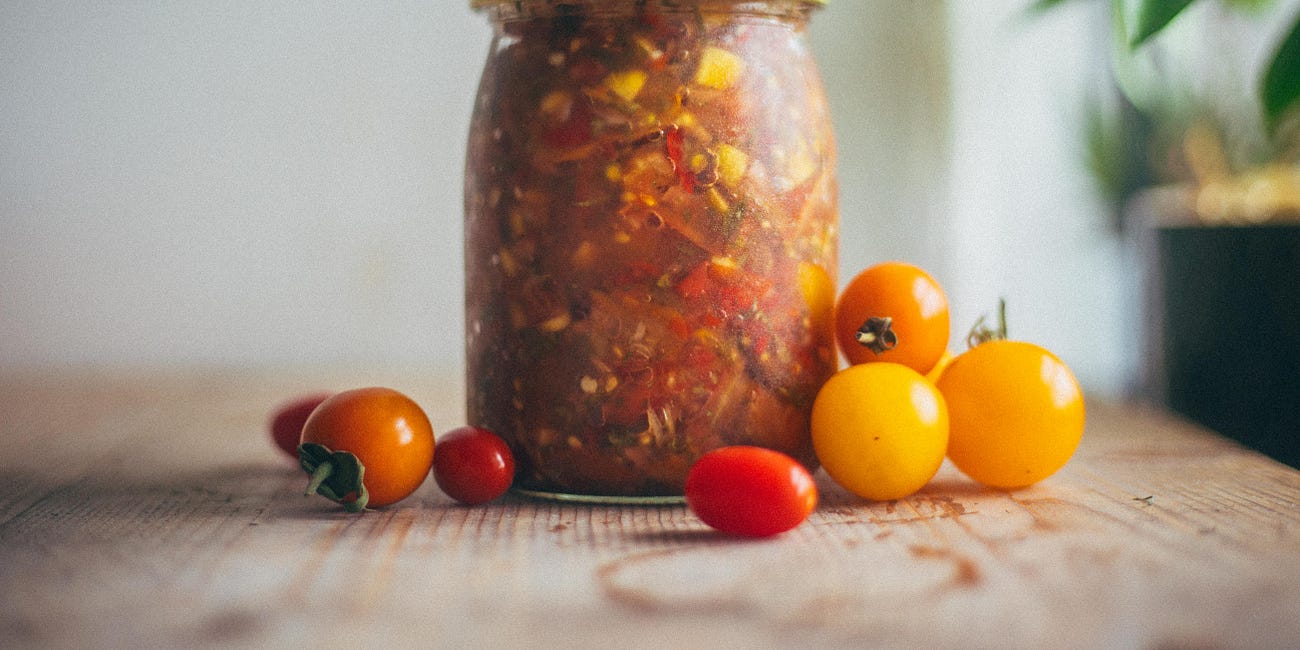It’s time to sow tomatoes. For undercover growing at least. If you grow them outdoors (here in the UK) you’ll need to wait until late March. Either way, you have time to buy some seeds, get your compost ready, sort through your old pots, and prepare to grow some of the best tomatoes you’ve ever tasted.
For this newsletter I thought I’d cover some of the most successful tomato varieties we’ve grown over the years and share with you the stand out tomatoes for specific kitchen techniques. Which made the best sauce, which fermented beautifully, which were sweeter, which had more umami, and one in particular that dehydrated in the most incredible way.
For paid members, I’ll also be able to share with you the technique I’ve written for mine and Huw’s next book on making a rustic, delicious, tomato sauce using heritage varieties (and no lemon juice), as well as a sneak peek at some of the illustrations I’ve been working on for the next book cover. More on that down below.
Where Tomatoes Grow
Towering vines line the raised beds, hungrily pressing themselves against the polytunnel walls in the muggy summer sun. Dappled light bathes my arms as I brush between them, gently pushing aside their swollen fruit as the smell of vines fills me. A flash of red catches my eye, distracting me from my duties with a watering can, and I reach out to test the tomatoes ripeness. Plump, soft, and warmer than my own hands. With a twist I pluck it free and eat it there and then. A tomato should never know the cold. I consider refrigerating them a sin against these glorious fruits, and why would you when there are so many ways to preserve them?
Some people tell me they don’t like tomatoes. So far, every one of these people have been converted when I give them one I’ve grown. Within minutes they go from reluctantly taking the fruit from my hand to devouring it like an apple, a look of bewilderment on their face as the juices run down their chin, in equal part surprised at their own actions, but also a look of confused puzzlement.
“Why don’t all tomatoes taste like this?”
The short answer - because 99% of tomatoes in shops aren’t grown well.
Fresh tomatoes in our shops taste little more than sour water, with none of the sweetness, complexity, or umami of home grown. I dread to think how they’re being produced, and why they still sit there on supermarket shelves in the dead of winter, looking as confused about their existence as we are, and tasting of sorrow and regret.
It doesn’t even stop there. For these tomatoes, varieties are selected based on size, uniformity, and speed. Not flavour. And flavour is the language of nutrition. In favour of uniformity, we have traded diversity.
Even in Italy, where tomatoes are a point of national pride (99% of Italians are at least 50% tomato genetically), there has been recent controversy as lab testing on ‘100% Italian tomato sauce’ found Chinese imported tomatoes known to come from regions where human rights for those involved in farming are on shaky grounds. If you want to find out more about this, read here.
There are more types of tomato than you could possibly hope to grow in one lifetime. Each with its own characteristics and charm. In a recent video I edited for Huw’s Youtube channel of the team at Vital Seeds, they even spoke about how they’ve ‘rewilded’ a hybrid F1 cherry tomato to retain its flavour, appearance, and reliability, whilst gaining the benefit of producing true seeds for the next generation (watch below if you’re interested).
This is a remarkable feat as it takes a seed owned by a monopoly and gifts it back to us, the people. Now, if you want to save seed from the tomatoes you’ve grown, you can. And they will produce more tomatoes the following year. And you should do this! Because tomatoes are one of the easiest plants to save seed from. Simply grow them as you would to eat (as I’ve outlined down below) but reserve a few for seeds towards the end of the season.
Tomato Varieties We Love
Lulu - The sheer size, juiciness, and flavour really lends itself to fermentation and sauces. Pleasantly sweet and umami, with enough acidity to bolster against spoilage.
Green Zebra - Tricky to tell when it's ripe until you’re familiar with it, but delicious in salads and sandwiches.
Shimmer (F1 plum)- Incredibly umami tomato that dehydrates well to concentrate its flavour. Once dehydrated, turn it into crisps, a powder, or rehydrate in oil like sundried tomatoes.
Honeycomb - The sweetest tomato I’ve ever tasted. A bright orange cherry variety that handles cooking and can be eaten raw.
Black Russian - Huge. Very tasty. And looks incredible when cut open.
Black Strawberry - The definition of abundance, this large cherry variety just doesn’t stop producing a vast number of fruits. Easy to grow and delicious in sauces. Not so great eaten fresh as they’re tough and a bit astringent.
Yellow Perfection - An unimaginative but accurate name. This cherry tomato is a classic all-rounder with superior sweetness and flavour, but keep an eye on them. By staying yellow it can be easy to miss ripe fruits which soften and drop.
All featured in the photo above.
GROW YOUR OWN
1. Sowing Tomato Seeds
When to Sow
Indoors: Late February to early April
Outdoors: Mid to late May (after the risk of frost has passed)
How to Sow
Choose the Right Seeds – Opt for organic, disease-resistant varieties suited to your climate.
Use Seed Trays or Modules – Fill with fine, peat-free compost.
Sow Seeds Shallowly – Place seeds about 0.5 cm (¼ inch) deep and cover lightly with compost.
Water Gently – Use a spray bottle or watering can with a fine rose to keep the compost moist but not waterlogged.
Provide Warmth – Keep trays at 18–21°C (65–70°F) in a greenhouse, propagator, or sunny windowsill.
Germination Time – Seeds typically sprout in 7–14 days.
2. Transplanting Seedlings
First Potting On (After First True Leaves Appear)
Carefully transfer seedlings to individual 7 cm (3-inch) pots filled with rich compost.
Bury the stem slightly deeper to encourage strong root growth. Tomatoes can grow roots from almost any part of themselves, which you’ll see later on when fully grown plants try to root from above head height.
Harden Off Before Planting Out
From late April to early May, gradually acclimatise plants to outdoor conditions over 7–10 days.
Move them outside for increasing periods each day but bring them in at night.
3. Planting Out
When: Late May to early June (when night temperatures stay above 10°C (50°F)).
Where to Grow:
Greenhouse: Ideal for earlier and more reliable crops.
Outdoor Beds: Choose a sheltered, sunny spot.
Containers/Grow Bags: Use at least 30 cm (12 inches) deep containers.
How to Plant:
Spacing: 45 cm (18 inches) apart for cordon types; 60 cm (24 inches) for bush varieties.
Deep Planting: Bury stems up to the first set of leaves to encourage strong roots.
Fertility: We always put a large handful of fresh compost in the bottom of the hole and sink the tomato plant into it before piling the soil back over. This gives the young plant a bank of nutrients and encourages the roots to grow down into it.
4. Organic Tomato Care
Watering
Keep soil evenly moist to prevent blossom end rot and splitting.
Water early in the morning or evening, avoiding splashing leaves.
Feeding
Start feeding once flowers appear using organic fertilisers like:
Homemade Comfrey or Nettle Tea
Liquid Seaweed Fertiliser
Organic Tomato Feed with High Potassium (K)
Supporting Plants
Cordon (indeterminate) varieties need staking with canes or strings.
Pinch outside shoots weekly to focus energy on fruit production. You can spot these as they appear in the ‘elbow’ area between the main stem and the branches, pointing up, like a new small tomato. If you’re pinching these out early in the season and fancy a few more tomatoes, they root easily and can be planted in fresh compost for a free new plant.
5. Pest & Disease Management (Organic)
Companion Planting
Marigolds (repel whitefly), Basil (improves flavour), and Nasturtiums (trap aphids).
Mulching
Straw, grass clippings, or compost help retain moisture and suppress weeds.
Ventilation
Prevent fungal diseases by ensuring good airflow around plants. Remove lower leaves to increase airflow around the plant as it grows. By the time tomatoes appear, the leaves should be removed up to where the tomatoes are to encourage ripening in sunlight and avoid disease. By late season the plants will hardly have any leaves left.
Organic Pest Control
Garlic spray against aphids.
Lay straw around the base of the plants to encourage habitat for beetles and mulch the soil to slow evaporation rate. Beetles are the number one predator for slugs and snails.
6. Harvesting & Storage
Pick when fully ripe for the best flavour.
Store at room temperature, refrigerating dulls the taste and texture.
Green tomatoes? Ripen on a sunny windowsill, make chutney, or lacto ferment them!
Looking for a great tomato ferment? Try my fermented tomato relish from last year.
Quick Fermented Relish | Four Ways to Use it #5
Before we start, Substack seems to have limited control over how I can post content for free vs paid members. Because of this, I’ve opted to make this newsletter free and remove all paywalls, but I’ve also posted the final recipe for paid members only as part of a separate post. If you’d like access to it, please consider supporting my work and joining …
Below this paywall is the skin-on tomato sauce for heritage and heirloom tomatoes from the upcoming book Huw and I are writing. It also includes a handful of my favourite ways to use it. Below that I thought I’d share some of the version 1 illustrations I’ve been working on for the next cover.
If you aren’t a paid member and must part ways here, thank you for joining me this week as we ramp up for another fantastic and no doubt challenging growing season. I hope you have a wonderful week and I look forward to seeing you soon. If you could be so kind as to share or restack this post before you head off, it makes a huge difference to the success of this Substack and (hopefully) spreads the joy of homegrown tomatoes far and wide.
However, if you aren’t quite ready to leave, you can either redeem your one free paid post to unlock the following recipe or support my work by becoming a paid member. Click the button below.
Keep reading with a 7-day free trial
Subscribe to The Black Butter Club to keep reading this post and get 7 days of free access to the full post archives.







